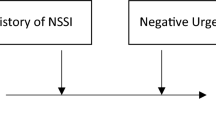Abstract
Recent evidence suggests a potentially important relationship between guilt and compulsive washing. The present studies sought to clarify this relationship. In Study 1, we examined whether washing reduced guilt. Following guilt induction, 132 non-clinical participants were randomized to one of three conditions: hand-wiping, straightening of clutter, or a control task. Contrary to predictions, analyses indicated no differences between conditions in post-task guilt. Moderator analyses indicated that among those in the straightening task, higher ordering symptoms were associated with greater increases in guilt. Study 2 examined whether guilt increased washing behavior. Sixty-one non-clinical participants were randomized to either a guilt induction or neutral condition. Afterwards, participants were timed as they cleansed their hands. Individuals in the guilt induction condition washed significantly longer than those in the neutral condition. These findings suggest that hand-washing does not lead to unique reductions in guilt, but guilt may prolong hand-washing behavior. Theoretical and clinical implications are discussed.
Similar content being viewed by others
References
Beck, A. (1972). Depression: Causes and treatment. Philadelphia: University of Pennsylvania Press.
Coles, M. E., Frost, R. O., Heimberg, R. G., & Rheaume, J. (2003). “Not just right experiences:” Perfectionism, obsessive-compulsive features and general psychopathology. Behaviour Research and Therapy, 41(6), 681–700.
Cougle, J. R., Lee, H.-J., Horowitz, J. D., Wolitzky-Taylor, K. B., & Telch, M. J. (2008). An exploration of the relationship between mental pollution and OCD symptoms. Journal of Behavior Therapy and Experimental Psychiatry, 39(3), 340–353.
Elliott, C. M., & Radomsky, A. S. (2009). Analyses of mental contamination: Part I, experimental manipulations of morality. Behaviour Research and Therapy, 47, 995–1003.
Fairbrother, N., & Rachman, S. (2004). Feelings of mental pollution subsequent to sexual assault. Behaviour Research and Therapy, 42, 173–189.
Fairbrother, N., Newth, S. J., & Rachman, S. (2005). Mental pollution: Feelings of dirtiness without physical contact. Behaviour Research and Therapy, 43(1), 121–130.
Fayard, J. V., Bassi, A. K., Bernstein, D. M., & Roberts, B. W. (2009). Is cleanliness next to godliness? Dispelling old wives’ tales: Failure to replicate Zhong and Liljenquist (2006). Journal of Articles in Support of the Null Hypothesis, 6(2), 21–30.
Fergus, T. A., Valentiner, D. P., McGrath, P. B., & Jencius, S. (2010). Shame- and guilt-proneness: Relationships with anxiety disorder symptoms in a clinical sample. Journal of Anxiety Disorders, 24(8), 811–815.
Foa, E. B., Huppert, J. D., Leiberg, S., Langner, R., Kichic, R., Hajcak, G., et al. (2002). The obsessive-compulsive inventory: Development and validation of a short version. Psychological Assessment, 14(2002), 485–496.
Gangemi, A., Mancini, F., & van den Hout, M. (2007). Feeling guilty as a source of information about threat and performance. Behaviour Research and Therapy, 45, 2387–2396.
Huppert, J. D., Walther, M. R., Hajcak, G., Yadin, E., Foa, E. B., & Simpson, H. B. (2007). The OCI-R: validation of the subscales in a clinical sample. Journal of Anxiety Disorders, 21, 394–406.
Jones, W. H., Schratter, A. K., & Kugler, K. (2000). The guilt inventory. Psychological Reports, 87(3, part 2), 1039–1042.
Klass, E. T. (1990). Guilt, shame, and embarrassment: Cognitive—behavioral approaches. In H. Leitenberg (Ed.), Handbook of social and evaluation anxiety (pp. 385–416). New York: Plenum Press.
Kugler, K., & Jones, W. H. (1992). On conceptualizing and assessing guilt. Journal of Personality and Social Psychology, 62, 318–327.
Lang, P. J., Bradley, M. M., & Cuthbert, B. N. (2008). International affective picture system (IAPS): Affective ratings of pictures and instruction manual. Technical report A-8. Gainesville, FL: University of Florida.
Mancini, F., Gangemi, A., Perdighe, C., & Marini, C. (2008). Not just right experience: Is it influenced by feelings of guilt? Journal of Behavior Therapy and Experimental Psychiatry, 39, 162–176.
Rachman, S. (1993). Obsessions, responsibility and guilt. Behaviour Research and Therapy, 31, 149–154.
Rachman, S. (2004). Fear of contamination. Behaviour Research and Therapy, 42, 1227–1255.
Radomsky, A. S., & Elliott, C. M. (2009). Analyses of mental contamination: Part II, Individual differences. Behaviour Research and Therapy, 47, 1004–1011.
Radomsky, A. S., & Rachman, S. (2004). Symmetry, ordering and arranging compulsive behaviour. Behaviour Research and Therapy, 42, 893–913.
Rapoport, J. L. (1989). The boy who couldn’t stop washing: The experience and treatment of obsessive-compulsive disorder. New York: Penguin Books.
Salkovskis, P. M. (1985). Obsessional-compulsive problems: A cognitive-behavioral analysis. Behaviour Research and Therapy, 23, 571–583.
Shafran, E., Watkins, T., & Charman, G. (1996). Guilt in obsessive-compulsive disorder. Journal of Anxiety Disorder, 10, 509–516.
Shakespeare, W. (1964). The tragedy of Macbeth. New York: Oxford University Press.
Steketee, G., Grayson, J., & Foa, E. (1987). A comparison of characteristics of obsessive-compulsive disorder and other anxiety disorders. Journal of Anxiety Disorders, 1, 325–335.
Wahl, K., Salkovskis, P. M., & Cotter, I. (2008). ‘I wash until it feels right’ the phenomenology of stopping criteria in obsessive-compulsive washing. Journal of Anxiety Disorders, 22(2), 143–161.
Watson, D., & Clark, L. A. (1994). The PANAS-X: Manual for the positive and negative affect schedule-expanded form. University of Iowa: Unpublished manuscript.
Zhong, C. B., & Liljenquist, K. (2006). Washing away your sins: Threatened morality and physical cleansing. Science, 313, 1451–1452.
Author information
Authors and Affiliations
Corresponding author
Rights and permissions
About this article
Cite this article
Cougle, J.R., Goetz, A.R., Hawkins, K.A. et al. Guilt and Compulsive Washing: Experimental Tests of Interrelationships. Cogn Ther Res 36, 358–366 (2012). https://doi.org/10.1007/s10608-011-9359-x
Published:
Issue Date:
DOI: https://doi.org/10.1007/s10608-011-9359-x




